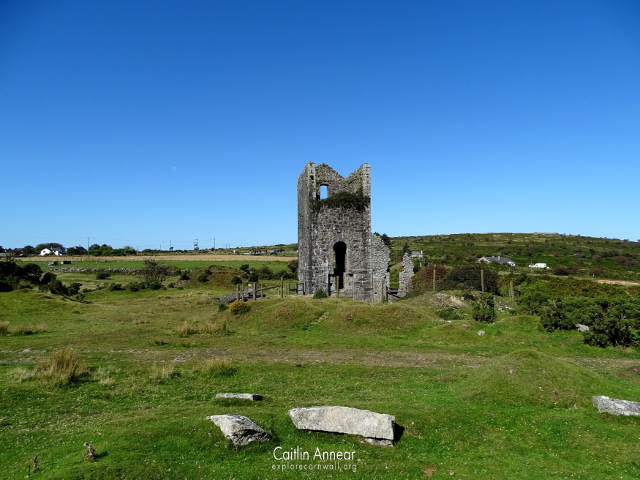Just on the outskirts of Minions Village on Bodmin Moor sits one of the most famous engine houses in Mid Cornwall, that of the small Wheal Jenkin mine.

At work by 1824, the first mining on this site was done via adits and shallow shafts. By 1836 it was part of the Cornwall Great United Mining Association and had its first engine house erected. This was a small 36″ engine that both stamped and pumped via flatrods out of Wheal Jenkin and neighbouring Wheal Prosper shafts. This venture only lasted until the following year when it was forced to close after suffering major financial loses.

Remains of the stamps engine.
In 1872 the Wheal Jenkin sett was acquired by the Marke Valley mine. In 1881 Whim shaft was renamed Bellingham’s and a new stamps engine house was built, possibly for a 36″ engine from Marke Valley which both pumped and stamped. 1886 saw the a new engine house built for Bellingham’s shaft, with the 70″ engine being moved from the now abandoned Marke Valley sire. Following this the stamps engine had its flat rods removed and another 12 heads of stamps were added.

All of this effort proved to be futile and the mine closed for a final time in 1890 after failing to make profits. Five large and two small engines were put up for sale, although some of these were from the Marke Valley or West Rosedown sites.

The stamps engines chimney.
Over its life the site had a number of engine houses at work. The first was a 36″ engine built in 1836 which would have stood near the site of the remaining stamps. This was built to pump via flatrods and had 40 heads of stamps. In 1882 a 36″ stamps engine was moved from Marke Valley into a new house and drove 24 then later 36 and 48 heads of stamps. It also pumped Bellingham’s shaft via flatrods, although these were later removed.
In 1884 another engine, this time an 18″ horizontal whim was moved from Marke Valley, although little remains today. In 1886 a new engine house was built next to Bellingham’s shaft for the 70″ pumping engine from Marke Valley. There was also evidence of three whim engines on Whim, Crease’s and Pink shafts, although one of these is likely the 18″. At time of sale, seven engines were sold, along with a 4″ horizontal engine and a 10×12″ air compressor.
Bellingham’s/Whim (117-fathoms/214m), Crease’s, Pink, Bullock’s Engine, Adit and Engine.
Worked two lodes.
1872-90: 388 tons black tin.
1881-90: 292 tons black tin.

The whole site is free to access from public footpaths, however none of the shafts have been capped by modern standards and remains unsafe. It is also advised to keep dogs on leads in the area as it is active farm land.
There is free parking available in the village.
Brown, K. and Acton, B. (1997) Exploring Cornish Mines: Volume Three. Truro: Landfall Publications.
Dines, H. G. (1956) The metalliferous mining regions of south-west England. British Geological Survey.
Nance, D., Brown, K. and Clarke, T. (2019) A Complete Guide to the Engine Houses of Mid-Cornwall. Lydney: Lightmoor Press.
Sharpe, A. (1989a) The Minions Survey Part 1. Truro. Available at: http://map.cornwall.gov.uk/reports_event_record/1989/1989R018.pdf.
Sharpe, A. (1989b) The Minions Survey Part 2. Truro. Available at: http://map.cornwall.gov.uk/reports_event_record/1989/1989R019.pdf.


